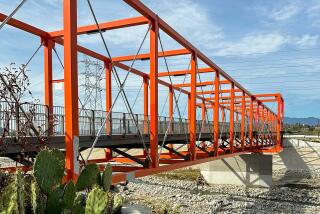Caution: pedestrian crossing
- Share via
Nearly 5,000 pedestrians are mowed down by cars each year across the nation, making up nearly 12% of total highway deaths. Walking down the street should be a lot safer -- and would be a lot safer -- if both motorists and pedestrians had a better understanding of the rules of the road.
The issue of pedestrian safety came up in a recent letter from a reader, Paul Eklof, who asked: “Does the law require that a driver making a right-hand turn on green stop and wait for a pedestrian who has just stepped off the curb on the other side of the intersection -- even when the street is six lanes wide?”
It is a good question that I have been asked repeatedly in reaction to recent columns I have written about the California Motor Vehicle Code. Eklof notes that he was not ticketed, but had been warned by police that he was violating the law by making a turn when a pedestrian was anywhere in the crosswalk.
There is a huge amount of confusion about pedestrian rights, and the toll is significant.
A detailed federal analysis of pedestrian safety in 2001 reported 4,882 deaths. The good news is that the figure is down from 5,801 in 1991. A lot about this issue is obvious: The young and old are most likely to be hit; it’s more dangerous at night than during the day.
And some places are a lot more dangerous than others. In California, 711 people on foot were killed by a car in 2001, representing 17% of all highway deaths. With a rate of 2.1 pedestrian deaths per 100,000 residents, California is a lot less safe than North Dakota, which lost just .5 pedestrians per 100,000 residents. New Mexico ranks worst with a rate of 3.9 per 100,000.
A look at our state’s vehicle code makes clear that mixing vehicle and foot traffic is a risky business. It is one of the few areas of the code in which the legislature almost begs for help, stating “it is the intent of the Legislature that all levels of government in the state work to provide convenient and safe passage for pedestrians and reduce pedestrian fatalities and injuries.”
It’s easier said than done, just as confusion about Eklof’s question implies.
In fact, the vehicle code does not require that a motorist wait until a pedestrian is out of the crosswalk to complete a turn or pass through a crosswalk, but it does require that the motorist yield to the pedestrian when he or she has the legal right of way.
It sounds easy, but it can get confusing and it goes to the heart of the often-quoted but erroneous maxim that the pedestrian always has the right of way. Vehicle Code Section 21950 states that “the driver of a vehicle shall yield the right-of-way to a pedestrian crossing the roadway within any marked crosswalk or within any unmarked crosswalk at an intersection, except as otherwise provided in this chapter.”
Lt. Joe Whiteford of the California Highway Patrol says that a driver must wait only until it is safe to proceed through the crosswalk. A violation occurs if the pedestrian must take evasive action or stop to allow the vehicle to pass through. In that case, the motorist has violated the pedestrian’s right of way.
So, if the pedestrian is walking away from the car, it is legal to proceed through the crosswalk when the pedestrian is a safe distance away. When the pedestrian is walking toward a car, it is legal to go through the crosswalk if the pedestrian is far enough away so that he or she does not have to slow down or stop for the vehicle to complete the turn.
In Eklof’s scenario, it would be legal to complete the turn if the pedestrian had only stepped off the curb of a six-lane street and was walking toward the car. But by the time the pedestrian is in the middle of the street, it is almost certainly too late, according to Whiteford.
The bottom line is that the pedestrian does not always have the right of way.
The code states in section 21950b that the requirement of a driver to yield to a pedestrian in a crosswalk “does not relieve a pedestrian from the duty of using due care for his or her safety. No pedestrian may suddenly leave a curb or other place of safety and walk or run into the path of a vehicle that is so close as to constitute an immediate hazard. No pedestrian may unnecessarily stop or delay traffic while in a marked or unmarked crosswalk.”
When a pedestrian does not have the right of way and is hit by a motor vehicle, the driver is often not cited or charged with a criminal offense. Such an outcome is nonetheless tragic. The law only vaguely defines the moral responsibility of the driver to exercise care as part of the solution to reducing pedestrian deaths.
Ralph Vartabedian can be reached at [email protected].
More to Read
Sign up for Essential California
The most important California stories and recommendations in your inbox every morning.
You may occasionally receive promotional content from the Los Angeles Times.











